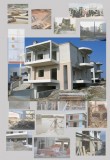Supervisor:
Technology
2005
Designers, architects and all who are evolved in building constructions worldwide, are focused on an effort to reduce the environmental impact of building constructions. Although, many designers or architects pretend that their projects are sustainable, if there is not conducted an objective analysis, it is not possible to estimate the environmental impact that a construction has. The total energy use during the life cycle of a building is a new field of research. A significant amount of energy is spent during the production processes and transportation of building materials. Energy saving is also significant for the reduce of CO2 emissions to the atmosphere that causes the greenhouse phenomenon. Nowadays roughly 50% of total energy consumption is owed in the buildings. Hence exists a imperative need for further reduction in the energy consumption. This fact has caused an intense research in the production processes of building materials, the construction methods, the way of use and their disposal. Recycling and re-use of building elements, wherever it is possible, give a chance of reducing the embodied energy of building materials and of the whole construction.
The aim of the research that follows, is the estimation of the environmental impact of a building construction. For this aim, took place an analysis and calculation of the embodied energy of building materials (necessary energy for the production, the transportation of materials and finally the use of the house model for 50 years. In Greece, there is a gap in this field and the hardly enough analysis that are carried out, are based on global data. Information about terms such as Life Cycle Analysis, Embodied Energy and Energy of Use and about similar researches in other countries are mentioned at the beginning. This research is based on data that was given from greek industries who produce building materials. Also, some design principles have been applied to the model in an effort to reduce the energy needs of the model (energy needs during the use of it, energy expense for its building materials and energy for the maintenance of the construction). There is used a new method for the time estimation of the replacement of building elements of the model.
According to the results of this research, the embodied energy of this building, comes up to the 55% of the whole energy use (building’s life cycle energy) in this house model. With the incorporation of bioclimatic principles during the model’s design, the energy saving is to low. So, as a result, it can be said that if we really want to reduce the energy expense during the construction and the 50 years use of this model, the careful choice of building materials during the construction is essential (materials with low energy need during the production, materials that are produced near the building construction and the most important of all: materials that can be recycled and re-used).
In such an approach of issues as Life Cycle Analysis of building materials and with a method that consumes the energy during the use of a construction, a choice of a building method, technologies and materials can be made and it would be a decision based on a demonstrated energy saving. In this way, the impact and the unenviable consequences on the environment and on public health (as an extension) of building constructions can be really reduced.
